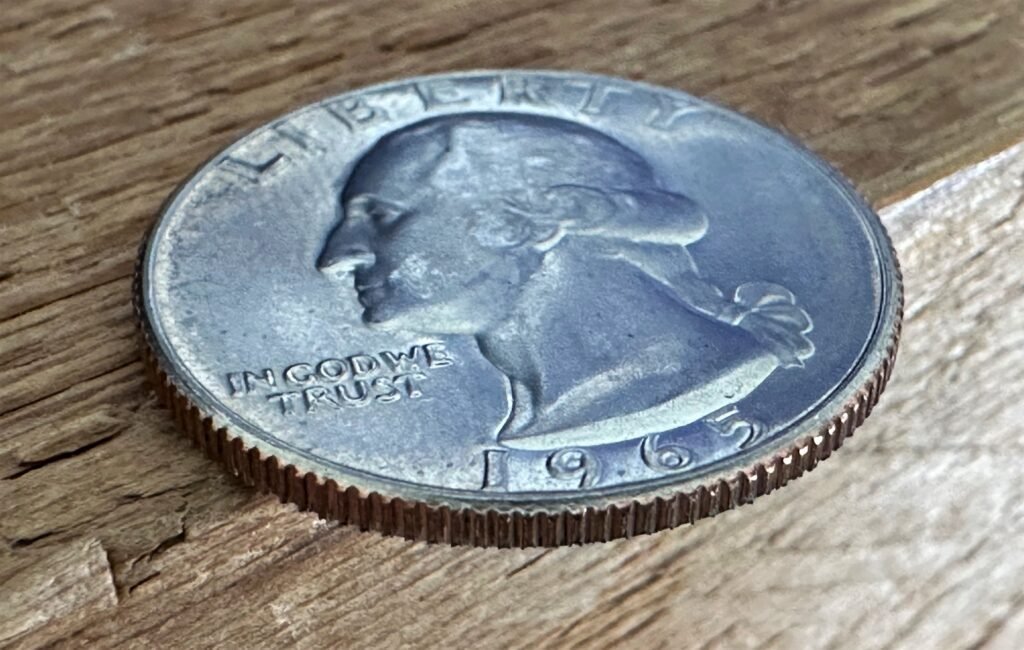The 1965 Washington quarter has fascinated collectors for decades. At first glance, it looks like an ordinary coin you’d find in spare change. Yet some 1965 quarters have sold for thousands of dollars at auction. Why? Because of rare minting errors, historical changes in U.S. coinage, and the transition away from silver.
If you’ve ever asked yourself “How much is a 1965 quarter worth?”, this guide covers everything. You’ll learn its history, composition, grading, and how to spot rare error coins that command serious money.
Historical Background
The Shift from Silver to Clad Coins
Until 1964, U.S. quarters were made of 90% silver and 10% copper. But rising silver prices caused the government to rethink coinage. By 1965, the U.S. Mint switched to a copper-nickel clad composition to reduce costs and prevent hoarding.
This makes the 1965 quarter historically important: it was the first year the Washington quarter was minted without silver. Collectors call it a “transitional year,” making certain varieties especially valuable.
Design of the 1965 Quarter
The coin kept the same design as earlier silver quarters:
- Obverse (front): Bust of George Washington, designed by John Flanagan in 1932.
- Reverse (back): Heraldic eagle with spread wings, holding arrows and olive branches.
Though the design didn’t change, the metal composition did, which is why 1965 quarters attract attention.
Mintage and Circulation
The U.S. Mint produced an enormous number of 1965 quarters over 1.8 billion. With such a high mintage, most coins are common and only worth face value. However, rare mint errors, especially silver planchet strikes, can be highly valuable.
What Makes a 1965 Quarter Valuable?
While most 1965 quarters are only worth 25 cents, several factors can increase their value significantly.
Composition and Weight
- Standard 1965 quarter: Copper-nickel clad, weighing 5.67 grams.
- Rare silver error quarter: Struck on leftover silver planchets from 1964, weighing 6.25 grams.
That tiny difference in weight can mean the difference between pocket change and thousands of dollars.
Errors and Varieties
Some of the most valuable 1965 quarters are error coins. Common varieties include:
- Transitional error: A 1965 quarter struck on a 1964 silver planchet.
- Off-center strikes: Part of the design missing due to misalignment.
- Doubled dies: Lettering or images doubled due to a die error.
Condition and Grading
Coin collectors value condition as much as rarity. A 1965 quarter in circulation may only fetch face value, but uncirculated examples can bring in more. Coins graded MS65 or higher by professional services like PCGS or NGC are especially sought after.
Value by Condition
Here’s a quick breakdown of the typical value ranges:
| Condition | Estimated Value |
| Circulated | $0.25 (face value) |
| Uncirculated (MS60) | $1 – $3 |
| Brilliant Uncirculated (MS63) | $5 – $10 |
| Gem Uncirculated (MS65) | $25 – $50 |
| Superb Gem (MS67+) | $200 – $500+ |
| Rare Silver Error | $3,000 – $12,000+ |
Case Study: In 2019, a rare 1965 silver quarter error graded MS62 sold for $7,050 at auction. This shows how small differences like composition can skyrocket value.
How to Identify It
The holy grail for collectors is the 1965 silver quarter error. Here’s how you can spot one.
Weight Test
- Silver 1965 quarter: 6.25 grams.
- Clad 1965 quarter: 5.67 grams.
Use a precise digital scale to check weight.
Visual Clues
- Clad coin edges: Show a visible copper stripe.
- Silver coin edges: Solid silver color with no copper band.
Confirming Authenticity
If you suspect you have a silver 1965 quarter, get it authenticated by PCGS or NGC. Grading not only proves authenticity but also increases resale value.
Collecting the 1965 Quarter
Is It Worth Collecting?
For most collectors, the 1965 quarter isn’t rare. Billions exist. However, error coins and high-grade uncirculated examples make it worth searching for.
Tips for Collectors
- Check coin rolls: Bank rolls may contain high grade or error coins.
- Search estate sales and flea markets: Older collections sometimes surface here.
- Store properly: Use coin flips or albums to prevent damage.
Long-Term Investment Potential
While common 1965 quarters won’t increase in value, rare error coins have shown steady growth. Investors see them as niche assets with strong demand among specialists.
Frequently Asked Questions
Are 1965 quarters silver?
No, standard 1965 quarters are clad. Only rare errors were struck on leftover silver planchets.
How can you tell if you have a rare 1965 quarter?
Weigh the coin. If it weighs 6.25 grams and lacks a copper edge, it may be silver.
What is the most valuable 1965 quarter ever sold?
Some silver error quarters have sold for over $12,000 at major auctions.
Should you get a 1965 quarter graded?
Yes, if it’s uncirculated, error variety, or possibly silver. Grading authenticates and increases market value.
Final Thoughts
The 1965 quarter is a coin with two stories. On one hand, it’s one of the most common quarters ever minted, usually worth just face value. On the other, rare silver errors and high-grade examples can fetch thousands.
If you’re a collector, it’s worth checking your pocket change, coin rolls, or family coin jars. You never know when a rare 1965 silver quarter might appear. With values ranging from 25 cents to over $10,000, it’s a small piece of American history that could be sitting right in your hand.



